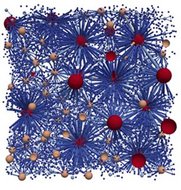IdGranPack
Identification of poly-disperse granular fabric for the assessment of the stability of widely graded soils under hydraulic load
The transport of particles in soil will always cause a change in the mechanical properties. This will affect the soil’s capacity to withstand stresses and the reliability of earthworks. In order to assess the soil’s stability, analysing the soil’s fabric and its transition is important. Although there is a long tradition in geotechnics of experimental and analytic investigations into the process of the transport of the soil’s material, there are no criteria for its stability based on analysis of the dominant fabric.
The aim of this research project is the identification of the fabric of widely graded soils in respect of their capacity to withstand transport of soil material. On the basis of an identifica-tion of the soil’s fabric, a general assessment of particle mobility and the soil’s stability is derived. The soil’s fabric is visualised, analysed, and identified through empirical investigation, 3D computed tomography images, and through numerical simulations. In these analyses, the soil is represented by granular packing of spheres.
This granular packing will be experimentally investigated and numerically simulated. To link both methods, a 3d data base of the experimentally produced packing is built. Digital image processing methods determine the relevant characteristic values of the packing. The resulting packings are used to validate and verify the numerical simulation. The main objective is the identification of the fabric and the assessment of the probability of mobility of particles. Based on the results of this assessment the packings are exposed to a specific hydraulic load. The outcome allows an assessment of the stability and global mobility of the mobile particles of packings of widely graded particle sizes.
This research develops methods of identification of the fabric of granular packings and particle transport. Based on this in dependency of the particle size distribution and bulk density a characteristic type of matrix for the fabric can be identified and the probability of mobility can be predicted. As a result, this research will contribute to techniques for assessing the capacity of earthworks to withstand transport of soil material under hydraulic loads. This allows more accurate assessments that minimize uncertainties in earthworks of flood protection.



Publications:
| Jahr | Autoren | Titel |
|---|---|
| 2017 | F. Seblany, U. Homberg, E. Vincens, P. Winkler, K.J. Witt: »Merging criteria for the definition of a local pore and the CSD computation of granular materials« Proceedings of the 25th meeting of the Working Group on Internal Erosion in em-bankment dams and their foundations, 04.-07.09.2017, Deltares (Delft, NL), ISBN: 978-90-827468-1-5, pp.150-159 |
| 2016 | P. Winkler, H. Jentsch, M.R. Salehi Sadaghiani; K.J. Witt: »Numerical Investigation of the particle Skeleton of widely graded soils prone to Suffusion« Proceedings of the 8th International Conference on Scour and Erosion (ISCE-8), 12.-15.09.2016. Oxford, UK, pp. 149-154 |
| 2016 | H. Jentsch; P. Winkler; M.R. Salehi Sadaghiani; K.J. Witt: »Experimental identification of the dominant fabric in widely graded soils« Proceeding of the 8th International Conference on Scour and Eroseion (ISCE-8), 12.-15.06.2016, Oxford, UK,pp. 439-444 |
| 2016 | P. Winkler: »Numerische Untersuchung zur Strukturänderung weitgestufter Böden« 34. Baugrundtagung, Forum für junge Geotechnik-Ingenieure, Beiträge der Spezialsitzung, Bielefeld 2016; Hrsg.: Deutsche Gesellschaft für Geotechnik e.V.; S. 97-104 |
| 2016 | H. Jentsch: »Identifikation weitgestufter granularer Packungen« 34. Baugrundtagung, Forum für junge Geotechnik-Ingenieure, Beiträge der Spezialsitzung, Bielefeld 2016, Hrsg.: Deutsche Gesellschaft für Geotechnik e.V.; S. 75-82 |
PROJECT DURATION:
4/2017 - 3/2020
DEPARTMENT:
Faculty of civil Engineering, Chair of Teotechnical Engineering, Prof. Dr.-Ing. Karl Josef Witt
Chair of Building Chemestry and Polymer Materials, Prof. Dr.-Ing. Andrea Osburg
FOUNDED BY:
DFG (German Research Foundation)

